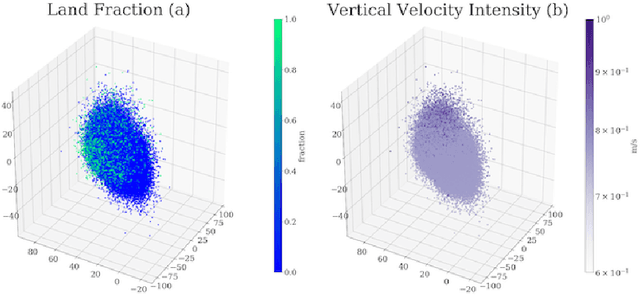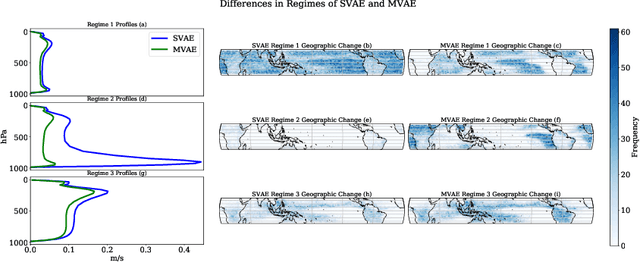Griffin Mooers
Neural General Circulation Models
Nov 28, 2023Abstract:General circulation models (GCMs) are the foundation of weather and climate prediction. GCMs are physics-based simulators which combine a numerical solver for large-scale dynamics with tuned representations for small-scale processes such as cloud formation. Recently, machine learning (ML) models trained on reanalysis data achieved comparable or better skill than GCMs for deterministic weather forecasting. However, these models have not demonstrated improved ensemble forecasts, or shown sufficient stability for long-term weather and climate simulations. Here we present the first GCM that combines a differentiable solver for atmospheric dynamics with ML components, and show that it can generate forecasts of deterministic weather, ensemble weather and climate on par with the best ML and physics-based methods. NeuralGCM is competitive with ML models for 1-10 day forecasts, and with the European Centre for Medium-Range Weather Forecasts ensemble prediction for 1-15 day forecasts. With prescribed sea surface temperature, NeuralGCM can accurately track climate metrics such as global mean temperature for multiple decades, and climate forecasts with 140 km resolution exhibit emergent phenomena such as realistic frequency and trajectories of tropical cyclones. For both weather and climate, our approach offers orders of magnitude computational savings over conventional GCMs. Our results show that end-to-end deep learning is compatible with tasks performed by conventional GCMs, and can enhance the large-scale physical simulations that are essential for understanding and predicting the Earth system.
ClimSim: An open large-scale dataset for training high-resolution physics emulators in hybrid multi-scale climate simulators
Jun 16, 2023Abstract:Modern climate projections lack adequate spatial and temporal resolution due to computational constraints. A consequence is inaccurate and imprecise prediction of critical processes such as storms. Hybrid methods that combine physics with machine learning (ML) have introduced a new generation of higher fidelity climate simulators that can sidestep Moore's Law by outsourcing compute-hungry, short, high-resolution simulations to ML emulators. However, this hybrid ML-physics simulation approach requires domain-specific treatment and has been inaccessible to ML experts because of lack of training data and relevant, easy-to-use workflows. We present ClimSim, the largest-ever dataset designed for hybrid ML-physics research. It comprises multi-scale climate simulations, developed by a consortium of climate scientists and ML researchers. It consists of 5.7 billion pairs of multivariate input and output vectors that isolate the influence of locally-nested, high-resolution, high-fidelity physics on a host climate simulator's macro-scale physical state. The dataset is global in coverage, spans multiple years at high sampling frequency, and is designed such that resulting emulators are compatible with downstream coupling into operational climate simulators. We implement a range of deterministic and stochastic regression baselines to highlight the ML challenges and their scoring. The data (https://huggingface.co/datasets/LEAP/ClimSim_high-res) and code (https://leap-stc.github.io/ClimSim) are released openly to support the development of hybrid ML-physics and high-fidelity climate simulations for the benefit of science and society.
Analyzing High-Resolution Clouds and Convection using Multi-Channel VAEs
Dec 01, 2021


Abstract:Understanding the details of small-scale convection and storm formation is crucial to accurately represent the larger-scale planetary dynamics. Presently, atmospheric scientists run high-resolution, storm-resolving simulations to capture these kilometer-scale weather details. However, because they contain abundant information, these simulations can be overwhelming to analyze using conventional approaches. This paper takes a data-driven approach and jointly embeds spatial arrays of vertical wind velocities, temperatures, and water vapor information as three "channels" of a VAE architecture. Our "multi-channel VAE" results in more interpretable and robust latent structures than earlier work analyzing vertical velocities in isolation. Analyzing and clustering the VAE's latent space identifies weather patterns and their geographical manifestations in a fully unsupervised fashion. Our approach shows that VAEs can play essential roles in analyzing high-dimensional simulation data and extracting critical weather and climate characteristics.
Generative Modeling for Atmospheric Convection
Jul 03, 2020



Abstract:To improve climate modeling, we need a better understanding of multi-scale atmospheric dynamics--the relationship between large scale environment and small-scale storm formation, morphology and propagation--as well as superior stochastic parameterization of convective organization. We analyze raw output from ~6 million instances of explicitly simulated convection spanning all global geographic regimes of convection in the tropics, focusing on the vertical velocities extracted every 15 minutes from ~4 hundred thousands separate instances of a storm-permitting moist turbulence model embedded within a multi-scale global model of the atmosphere. Generative modeling techniques applied on high-resolution climate data for representation learning hold the potential to drive next-generation parameterization and breakthroughs in understanding of convection and storm development. To that end, we design and implement a specialized Variational Autoencoder (VAE) to perform structural replication, dimensionality reduction and clustering on these cloud-resolving vertical velocity outputs. Our VAE reproduces the structure of disparate classes of convection, successfully capturing both their magnitude and variances. This VAE thus provides a novel way to perform unsupervised grouping of convective organization in multi-scale simulations of the atmosphere in a physically sensible manner. The success of our VAE in structural emulation, learning physical meaning in convective transitions and anomalous vertical velocity field detection may help set the stage for developing generative models for stochastic parameterization that might one day replace explicit convection calculations.
 Add to Chrome
Add to Chrome Add to Firefox
Add to Firefox Add to Edge
Add to Edge